
By Beth Judd
December 12, 2016
|
The famous Jabbekke TR2 has been stunningly restored, we take a look behind the scenes...
...and find out was it plain sailing or blood, sweat & tears?
Moss Europe would like to formally welcome the newly restored Triumph MVC 575 to their London show room!
After a year of hard work from Glen Hewitt and his team at Protek Engineering they have successfully finished restoring this record breaking car back to its former glory and with the help of Moss Europe supplying some very crucial parts to the restoration the MVC 575 is now running better than ever.
Now, just in case you have never heard of this car before here is a lowdown of how it became possibly the most significant Triumph in history and its special journey from the Jabbeke highway in Belgium to our showroom London.
The car made history in 1953 during speed trials held on a highway in Jabbeke, Belgium. Jabbeke was chosen because of its 8-mile dead straight section of highway. The road was used often during the '40s & '50s to test model's maximum speed and the results were certified by the Royal Automobile Club of Belgium.
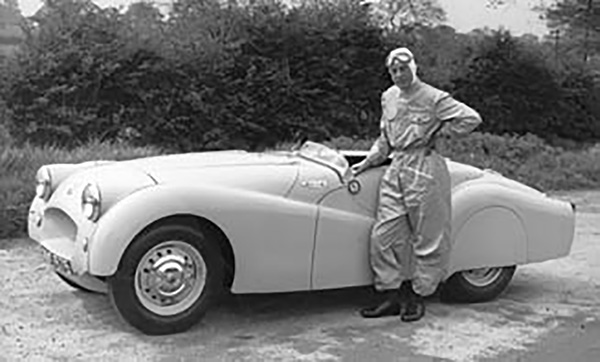 Test Driver Ken Richardson with the TR2 prototype circa 1953. Test Driver Ken Richardson with the TR2 prototype circa 1953.
Standard Triumph were keen to show the world that their new sports car was faster than its competitors such as the Sunbeam Alpine, that had completed the run in Jabbeke at 120.135mph earlier in the year. Beating their rivals was crucial for Triumph as some say the TR2 which we know today would not have been put into production.
Ken Richardson an experienced test driver, contributed to the development of the MVC 575 and undertook the challenge of driving the car in their record attempt. They began with making the car more aerodynamic by removing the hood and windscreen and to reduce even more drag the seats were removed and Ken completed the trial low down on a cushion.
On may 20th 1953 Triumph made their speed run at Jabbeke with MVC 575. On the first run, disaster struck! The car only achieved a speed of 104.86mph. The future of the TR2 was hanging in the balance but Ken noticed he was only running on 3 cylinders and found the fault rested with a loose spark plug. Once this was replaced the car could make a 2nd attempt. The 2nd run was a success! Smashing the record and hitting an average speed of 124.889mph, setting a new world record for two-litre production sports cars.
After the record runs, MVC 575 was used as a development car for the production TR2 model. After a few years the car was sold into private ownership and over the years its condition deteriorated. It remained in this state until 2015 when fate brought MVC 575 and Glen Hewitt together, where he took on the difficult task of restoring the car to its former glory.
So now you know a little bit more about the history of the car and are filled with excitement and anticipation, we recently caught up with Glen Hewitt to ask him a few questions about the extraordinary journey of the iconic Jabbeke Triumph MVC 575 has been on.
Moss: How did you come to own the car?
Glen: I was looking for a rear apron for a TR2 to complete a restoration for a customer, I was put in contact with known Triumph collector John Ames who has a large collection of Triumph cars & parts. Whilst chatting with him the subject of MVC 575 came up, John said he owned the car & would be prepared to sell it, so I did some research, made an offer & a deal was done.
“The car had been dismantled in the mid 1970s ready for restoration, but it never happened.”
Moss: What condition was it in before the restoration?
Glen: The car had been dismantled in the mid 1970s ready for restoration, but it never happened. It had been separated into parts and all were very rusty, but the chassis was in a very good shape.
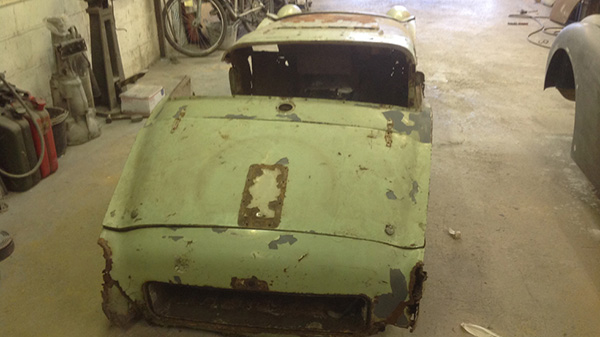
The TR2 MVC575 is delivered to the Protek Engeneering workshop to start its restorationin.
Moss: What were the most challenging parts of the restoration?
Glen: Pretty much every panel is unique to the Jabbeke car, so rotten panels were repaired rather than replaced. Missing parts were remanufactured to the original spec, photos and video footage helped with this. The trickiest parts to restore were the inner front wings! These are different to production TR2 models and were very badly rusted or partly missing, so many, many painstaking hours of repair work was needed.
Moss: How much of the restored car is original?
Glen: 70% of the car is original, including major panel work, chassis & the engine. The speedster tonneau has been recreated from photos and made to an exacting copy – even down to the spacing of the fixing screws being inconsistent – as they were originally! This car was a test vehicle and used for development, So no time was wasted on making sure screw holes were equally spaced just to hold the tonneau on!
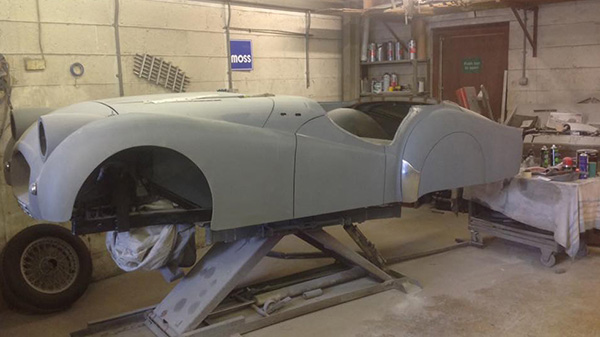
The TR2 MVC575 during its restoration.
Moss: How different is the car to a standard TR2?
Glen: Every panel is different to the production TR2 - they tested ideas on this car and improved the design for the production car. Things like the badge is different, rear number plate panel, front inner wing, fuel tank, side light position & bonnet hinge locations are all different to the standard TR2.
Moss: What parts did you use from Moss Europe?
Glen: I ordered almost 200 parts from Moss Europe, from a decorative hub cap, gear knob, fuel tank, to fabric and material for the interior.
Moss: Did you have to make many bespoke parts for the car – if so what did you use for reference?
Glen: We used photos and film as a reference but we didn’t have much to go on and everyone involved in the original project have now sadly passed away. From the photos and footage we could replicated the original paintwork using the traditional Triumph Ice Blue, but also could see the engine bay was painted a dark blue which is unusual and no one knows exactly why it is a different colour.
Moss: How long did the restoration take from start to finish?
Glen: Just less than one year, over 1,000 man hours.
Moss: What is it like to drive?
Glen: After only a few turns around the car park the car feels totally impractical – it is built for speed. The tonneau makes it hard to get in and out of. A proper seat would make a world of difference, even though Ken Richardson set the record sat on a cushion!
Moss: Will you be taking the car back to Jabbeke where it made its record breaking run?
Glen: Yes, the plan is to take it back next year (2017).
Moss: Do you think the car could repeat its magical 124.889mph record today?
Glen: Absolutely!
Moss: What’s next for the car?
Glen: After a few final jobs to finish the car off an official launch at The RAC Club in Pall Mall, London will happen.
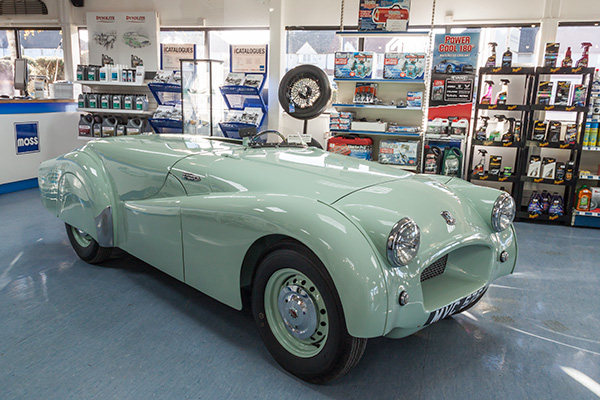
The beautifully restored TR2 MVC575 in the Moss London showroom.
“The car is now on its way back to Jabbeke for the first time since it broke the record!”
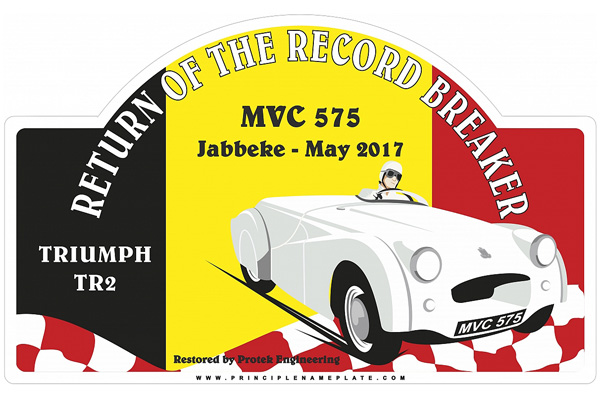 Record Breaking Triumph TR2 returns to Jabbeke. Record Breaking Triumph TR2 returns to Jabbeke.
The TR Register are orgnising a trip for its members to see the return of the record breaking Triumph TR2 to Jabbeke, Belgium, from Friday 19th to 22nd. To see the exciting itinery and perhaps jump onboard the trip visit the TR Register.

Keep up with all the latest from Moss Europe on our social pages.

|
|














